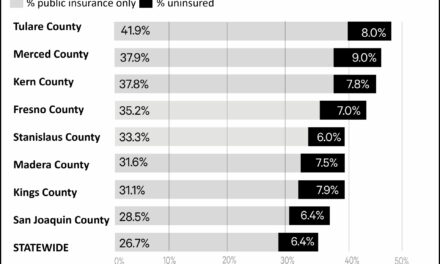BY RYAN SABALOW AND BRIANNA VACCARI
CV Journalism Collaborative
Lawmakers are poised to give California’s water districts legal cover from lawsuits as they work to meet strict new state standards for a cancer-causing toxic chemical.
It’s called hexavalent chromium, more commonly known as “chromium-6.” Drinking water with trace amounts of the chemical over long periods has been linked to cancer.
Last year, state water regulators approved a nation-leading drinking water standard for the chemical, which is found naturally in some California groundwater. In other areas, chromium-6 leached into the water from industrial sites.
The regulations are intended to protect more than 5 million Californians from the toxin, including in the Central Valley, Inland Empire and along the coast. Water districts say they plan to comply, but they complain the new rules are going to cost tens of millions of dollars, will jack up their customers’ water bills and could take years to complete.
They don’t want to spend even more ratepayer money defending themselves from lawsuits while they work to meet the new standards. Their concerns stem from the fact that they won’t be meeting state rules while upgrades to prevent contamination are underway. Water districts also would have to notify their customers that they’re not meeting the drinking-water standards, which the districts worry could create a wave of lawsuits.
Democratic Sen. Anna Caballero, whose sprawling San Joaquin Valley district includes water utilities affected by the new standard, heard their concerns.
She introduced Senate Bill 466, which aims to give water districts a break from spending ratepayer money on lawsuits as long as they’re making progress toward meeting their state-approved targets. The measure does not restrict state regulators’ enforcement authority.
“This just makes sense,” she said at an Assembly Judiciary Committee hearing last week. “It makes sure that they are protected so that they can put their resources to … bring(ing) the system up to their compliance plan.”
The bill passed the committee unanimously as it did the Senate earlier this year. It’s likely to be heard by the full Assembly after lawmakers reconvene in August from their summer recess.
Water districts support proposal
The measure has broad support from water districts across the state, including the city of Los Banos, which co-sponsored the bill.
Los Banos operates 11 wells to service 50,000 customers, and so far, the city has seen no evidence that its drinking water is dangerous to drink, Mayor Michael Amabile said.
Nestled just east of the Diablo Range, chromium-6 is naturally occurring in Los Banos’ ground water at varying degrees above the new state standards. During the winter, the city supplements its groundwater with surface water from the nearby Los Banos Creek, which sometimes brings chromium-6 levels down.
It would cost the city around $65 million in infrastructure to bring the city into compliance, Amabile said, which is half of the city’s annual budget.
“People shouldn’t be burdened just because of where they live,” Amabile said. “So if you’re on the east side of the (San Joaquin) Valley, you have absolutely no problems at all. If you’re on the west side of the Valley, you have all these issues.”
The city plans to comply with state requirements, but it’s not clear how the city is going to pay for the upgrades without financial assistance from the state, Amabile said. Any type of study that could propose a solution would take at least a year.
“I really don’t want to go down as the mayor that quadruples water rates, so I need the help from the state,” Amabile said.
At last week’s judiciary committee hearing, Scott Burritt, a representative for the Coachella Valley Water District, said the utility will have to spend $400 million to comply with the new rules – and that’s before anyone sues.
“Domestic water rates are expected to double,” Burritt told the committee. “This will have an enormous impact on the large disadvantaged communities that we serve, and it will also impact the retiree population, which is very large in our service area.”
The district provides drinking water to around 270,000 people in the Coachella Valley, which has naturally occurring chromium-6 in the area.
The influential lobbyists at the Consumer Attorneys of California opposed the original version of the measure, arguing it would have provided near total immunity for water districts, including if one had acted negligently.
“SB 466 grants public water systems a preemptive and absolute blanket shield from civil liability from negligence (such as causing cancer) related to drinking water with hexavalent chromium … so long as they are implementing — or even awaiting approval of — a compliance plan approved by the state Water Resources Control Board,” the attorneys wrote in a letter opposing the bill.
But Caballero, an attorney and former Salinas mayor, agreed to amend the bill last week to address the group’s concerns. The Consumer Attorneys’ spokesperson, Mike Roth, said the organization is satisfied with the changes, has removed its opposition and gone neutral on the bill.
Caballero has voted in accordance with the Consumer Attorneys’ positions on legislation 84% of the time, according to the Digital Democracy database.
The Erin Brockovich chemical
Hexavalent chromium was made infamous by the movie “Erin Brockovich.” The film dramatized Pacific Gas & Electric’s contamination of the water supply in the small California desert town of Hinkley.
Under the standards the state water board approved last year, water suppliers have to limit the chemical in water to no more than 10 parts per billion — equivalent to about 10 drops in an Olympic-sized swimming pool.
Levels above the new state limit have been reported in about 330 sources of drinking water in California.
Public health advocates say the new standard, while an improvement, doesn’t go far enough to reduce cancer risks. The new standard is one of the least protective of all the water contaminants regulated by California, according to a state analysis.
Under the new standard, for every 2,000 people who drink the water for a lifetime, one person would be at risk of cancer.
Some of the areas affected are the counties of Sacramento, Solano, Santa Cruz, San Bernardino, Santa Barbara, Monterey and Merced. The highest levels found were in Riverside, Yolo, Los Angeles and Ventura counties, although water suppliers may blend or treat the water to reduce the contaminants there.
The water board last year gave the largest water suppliers two years to comply with the new requirements; smaller ones with fewer than 1,000 connections were given four years. Those that can’t meet the deadlines must create state-approved plans that they’ll need to follow to come into compliance. They could be fined if they don’t.
In 2023, the California Air Resources Board also approved a ban on use of hexavalent chromium by the chrome plating industry.
CalMatters water reporter Rachel Becker contributed to this story.
Los Banos dealing with a tough toxin problem
BY MIKE DUNBAR
Westside Express
The city of Los Banos is already trying to deal with one of the highest concentrations of a carcinogen in the Valley in its well water. It doesn’t want to be forced to defend against “predatory lawsuits” as well.
That’s why the city worked with Sen. Anna Caballero to write Senate Bill 466, to protect Los Banos and dozens of other public water providers against lawsuits. The law would shield communities as long as they are actively trying to remove hexavalent chromium from drinking water.
Hexavalent chromium, or Chromium-6, has been infamous since the 2000 movie “Erin Brockovich.” Julia Roberts portrayed the profane but heroic real-life lawyer who sued PG&E for having poisoned the water of Hinkley over the course of three decades. Used to protect metal from rust, Chromium-6 was dumped by the company into unlined waste ponds turning the Mojave Desert town of 600 into a cancer hotspot and resulting in a settlement of $333 million.
Such huge payouts would have enormous impacts on any city – crippling the community’s ability to respond to the crisis or even provide basic services. It would likely result in astronomical water bills – a prospect that terrifies those responsible for providing clean water.
Laws limiting the amount of Chromium-6 in water evolved from a 1991 federal recommendation that water contain no more than 100 parts per billion. In 2023, after two decades of discussions, the State Water Board adopted a standard of 10 parts per billion – or about 10 drops per 660,000 gallons.
Even that small amount remains controversial. A scientist who testified before the state told CalMatters last year that California’s new standards are “not terrible, but it’s not acceptable. … the most acceptable level is none.”
The coastal mountains of California naturally contain a devil’s brew of toxic chemicals from arsenic to Chromium-6 to uranium that all end up in groundwater for dozens of communities east of the range. When testing began for Chromium-6, it was discovered that some of the highest concentrations in the Valley were in western Merced County. One westside well tested at 39.6 parts per billion.
To meet Chromium-6 standards, Los Banos will need to spend an estimated $65 million on filtration. No city can afford to fix the problem and defend itself against multi-million-dollar legal actions at the same time. That’s why so many cities – from the Coachella Valley, to the coast, to the Imperial Valley and in the Central Valley – are seeking legislative protection. Los Banos has been at the forefront of that effort.
“You’ve got to take the lead,” said Mayor Michael Amabile, who first learned of the problem in 2017. “We’re talking millions of dollars in possible lawsuits. We need to save the money that our citizens pay to fix the problem.
“Even though we’re a little town, you have to think big. And you have to think you’re just as important as any big town.”
In the city of Los Banos, fixing the Chromium-6 problem is a high priority.
“If we’re following the water board’s criteria and mandates, we should be immune from lawsuits,” said Amabile. “You can’t just mandate something and — boom, you have it fixed the next day. It will take a few years to get this thing under control.”
Amabile was the only elected official to testify at in a Capitol hearing among various experts, scientists and attorneys.
“All the water districts got on our side, even Metropolitan (the state’s largest),” said Amabile. “We took the lead, and the Coachella Water District was with us.”
He believes Caballero, a former mayor and attorney who represents Merced County, was the right person to carry the legislation. “You can tell she’s very well respected in the Senate.”
Even if protection from lawsuits is signed into law, problems will remain. There’s the cost of filtration and then disposing of what is removed.
“They have to truck it to Kettleman,” said Amabile, “and that’s $2 million a year.”



